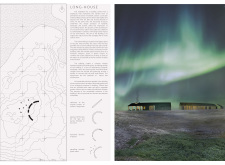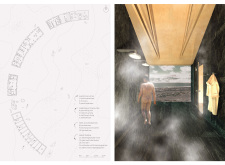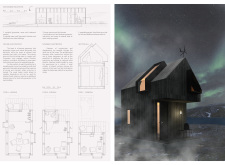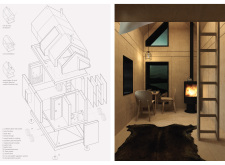5 key facts about this project
From the outset, the project reflects a vision that prioritizes sustainability and adaptability. The careful selection of materials plays a pivotal role in realizing this vision. Concrete, glass, wood, and metal are among the primary materials employed, each chosen for its performance characteristics and visual qualities. The use of concrete not only provides structural integrity but also serves as a symbol of permanence and robustness. Glass elements create transparency, allowing natural light to permeate interior spaces and fostering a sense of connection to the outdoors. Wood is utilized strategically to introduce warmth and texture, softening the otherwise stark aesthetic of concrete. Metal complements these materials, providing accents that enhance the contemporary appeal of the design.
The building’s layout is a key factor in its functionality, designed to facilitate movement and interaction. Open floor plans are utilized extensively to create versatile spaces that can adapt to various activities. This particular design approach encourages community engagement by allowing for fluid transitions between different areas, thereby promoting social interactions among users. The architects have employed innovative zoning techniques to separate public and private spaces effectively while maintaining an interconnected flow that invites exploration and collaboration.
Unique design elements further distinguish this project. For instance, the incorporation of green roofs and living walls not only enhances the building's environmental performance but also contributes to urban biodiversity. These features not only mitigate urban heat effects but also provide residents and visitors with a visually appealing landscape that changes throughout the seasons. The architects have also integrated sustainable technologies, such as solar panels and rainwater harvesting systems, demonstrating a commitment to reducing the environmental footprint of the building.
One of the standout features of the project is its relationship with the surrounding environment. The architectural design seamlessly integrates indoor and outdoor spaces, creating a dialogue between the building and its context. Expansive terraces and balconies serve as extensions of the interior, allowing occupants to enjoy outdoor spaces that promote well-being and relaxation. This connection with nature is fundamental, as it aligns with the prevailing trend in modern architecture that seeks to enhance the quality of life through thoughtful design.
The project is not merely a physical structure; it represents a conceptual shift in how we think about community spaces in urban areas. It embodies an architectural philosophy that embraces inclusivity and accessibility, offering a space that caters to a diverse user group. The careful consideration given to the needs of different demographics reflects a broader societal aim to create environments that foster belonging and interaction.
As one delves deeper into the specifics of this architectural endeavor, there is much to explore in terms of design details and spatial organization. The project is a testament to the potential of architecture to shape human experiences and interactions within communal spaces. For those interested in gaining a fuller appreciation of the project, examining the architectural plans, architectural sections, architectural designs, and architectural ideas related to this innovative undertaking is highly encouraged. Engaging with these elements will provide invaluable insights into the thoughtful considerations that have gone into this exemplary architectural work.


























